Instructions for Side by Side Printing
- Print the notecards
- Fold each page in half along the solid vertical line
- Cut out the notecards by cutting along each horizontal dotted line
- Optional: Glue, tape or staple the ends of each notecard together
A&P Final part 2
front 1 If you find an error | back 1 let me know by leaving a comment, so I can fix it! Good Luck!! |
front 2 If the length of the absolute refractory period in cardiac muscle
cells was the same as it is for skeletal muscle cells ________. B) contractions would last as long as the refractory period C) tetanic contractions might occur, which would stop the heart's pumping action D) it would be less than 1-2 ms | back 2 C) tetanic contractions might occur, which would stop the heart's pumping action |
front 3 During contraction of heart muscle cells ________. B) some calcium enters the cell from the extracellular space and triggers the release of larger amounts of calcium from intracellular stores C) the action potential is prevented from spreading from cell to cell by gap junctions D) calcium is prevented from entering cardiac fibers that have been stimulated | back 3 B) some calcium enters the cell from the extracellular space and triggers the release of larger amounts of calcium from intracellular stores |
front 4 Small muscle masses attached to the chordae tendineae are the
________. | back 4 C) papillary muscles |
front 5 Damage to the ________ is referred to as heart block. | back 5 D) AV node |
front 6 Select the correct statement about the structure of the heart wall.
B) Connective tissue in the heart wall aids in the conduction of the action potential. C) The heart chambers are lined by the endomysium. D) The myocardium is the layer of the heart that actually contracts. | back 6 D) The myocardium is the layer of the heart that actually contracts. |
front 7 Select the correct statement about the function of myocardial cells.
B) Each cardiac muscle cell is innervated by a sympathetic nerve ending so that the nervous system can increase heart rate. C) The refractory period in skeletal muscle is much longer than that in cardiac muscle. D) The influx of potassium ions from extracellular sources is the initiating event in cardiac muscle contraction. | back 7 A) The entire heart contracts as a unit or it does not contract at all. |
front 8 Compared to skeletal muscle, cardiac muscle ________. B) lacks striations C) has more nuclei per cell D) cells are larger than skeletal muscle cells | back 8 A) has gap junctions that allow it to act as a functional syncytium |
front 9 Which of the following is not an age-related change affecting the
heart? | back 9 D) thinning of the valve flaps |
front 10 The left ventricular wall of the heart is thicker than the right wall
in order to ________. B) expand the thoracic cage during diastole C) pump blood with greater pressure D) pump blood through a smaller valve | back 10 C) pump blood with greater pressure |
front 11 The tricuspid valve is closed ________. | back 11 B) when the ventricle is in systole |
front 12 The term for pain associated with deficient blood delivery to the
heart that may be caused by the transient spasm of coronary arteries
is ________. | back 12 D) angina pectoris |
front 13 Select the correct statement about the heart valves. B) The tricuspid valve divides the left atrium from the left ventricle. C) Aortic and pulmonary valves control the flow of blood into the heart. D) The AV valves are supported by chordae tendineae so that regurgitation of blood into the atria during ventricular contraction does not occur. | back 13 D) The AV valves are supported by chordae tendineae so that regurgitation of blood into the atria during ventricular contraction does not occur. |
front 14 If cardiac muscle is deprived of its normal blood supply, damage
would primarily result from ________. | back 14 A) decreased delivery of oxygen |
front 15 The P wave of a normal electrocardiogram indicates ________. | back 15 D) atrial depolarization |
front 16 The absorptive effectiveness of the small intestine is enhanced by increasing the surface area of the mucosal lining. Which of the following accomplish this task? A) plicae circulares and intestinal villi B) the vast array of digestive enzymes C) Brunner's glands D) the rugae | back 16 A) plicae circulares and intestinal villi |
front 17 Surgical cutting of the lingual frenulum would occur in which part of
the body? | back 17 A) tongue |
front 18 Pepsinogen, a digestive enzyme, is secreted by the ________.
| back 18 A) chief cells of the stomach |
front 19 When we ingest large molecules such as lipids, carbohydrates, and
proteins, they must undergo catabolic reactions whereby enzymes split
these molecules. This series of reactions is called ________.
| back 19 C) chemical digestion |
front 20 The ________ contains lobules with sinusoids (lined with macrophages)
that lead to a central venous structure. | back 20 A) liver |
front 21 The function of the goblet cells is to ________. | back 21 B) produce mucus that protects parts of the digestive organs from the effects of powerful enzymes needed for food digestion |
front 22 In addition to storage and mechanical breakdown of food, the stomach ________. A) initiates protein digestion and denatures proteins B) is the first site where absorption takes place C) is the only place where fats are completely digested D) is the first site where chemical digestion of starch takes place | back 22 A) initiates protein digestion and denatures proteins |
front 23 Hydrochloric acid is secreted by which of the secretory cells of the stomach? A) chief cells | back 23 B) parietal cells |
front 24 Which vitamin requires intrinsic factor in order to be absorbed?
| back 24 A) B12 |
front 25 The capillaries that nourish the epithelium and absorb digested
nutrients lie in the ________. | back 25 D) lamina propria |
front 26 The sheets of peritoneal membrane that hold the digestive tract in
place are called ________. | back 26 A) mesenteries |
front 27 Peristaltic waves are ________. | back 27 D) waves of muscular contractions that propel contents from one point to another |
front 28 ________ is (are) not important as a stimulus in the gastric phase of gastric secretion. A) Distension | back 28 B) Carbohydrates |
front 29 Hormones or paracrines that inhibit gastric secretion include
________. | back 29 B) secretin |
front 30 From the esophagus to the anal canal, the walls of every organ of the alimentary canal are made up of the same four basic layers. Arrange them in order from the lumen. A) muscularis externa, serosa, mucosa, and submucosa B) serosa, mucosa, submucosa, and muscularis externa C) submucosa, serosa, muscularis externa, and mucosa D) mucosa, submucosa, muscularis externa, and serosa | back 30 D) mucosa, submucosa, muscularis externa, and serosa |
front 31 Which of the following is not true of saliva? | back 31 B) contains enzymes that begin the breakdown of proteins |
front 32 Triglycerides found in foods such as butterfat molecules in milk are
split by a specific enzyme in preparation for absorption. Which of the
following enzymes is responsible? | back 32 C) lipase |
front 33 Chemical digestion in the small intestine involves ________. A) a significant amount of enzyme secretion by the intestinal mucosa B) cholecystokinin (CCK), an intestinal hormone responsible for gallbladder contraction C) secretions from the spleen that contain all enzymes necessary for complete digestion D) bile salts that help emulsify carbohydrates so that they can be easily digested by enzymatic action | back 33 B) cholecystokinin (CCK), an intestinal hormone responsible for gallbladder contraction |
front 34 Which of the following enzymes is specific for proteins? A) dextrinase | back 34 C) trypsin |
front 35 Which of the following is an essential role played by large intestine bacteria? A) produce gas B) absorb bilirubin C) synthesize vitamin K and B-complex vitamins D) synthesize vitamins C and D | back 35 C) synthesize vitamin K and B-complex vitamins |
front 36 The chemical and mechanical processes of food breakdown are called ________. A) digestion | back 36 A) digestion |
front 37 There are three phases of gastric secretion. The cephalic phase occurs ________. A) before food enters the stomach and is triggered by aroma, sight, or thought B) immediately after food enters the stomach, preparing the small intestine for the influx of a variety of nutrients C) at the end of a large meal, and the juices secreted are powerful and remain in the GI tract for a long period of time D) when the meal is excessively high in acids and neutralization is required | back 37 A) before food enters the stomach and is triggered by aroma, sight, or thought |
front 38 The terminal portion of the small intestine is known as the ________.
| back 38 B) ileum |
front 39 Digestion of which of the following would be affected the most if the
liver were severely damaged? | back 39 A) lipids |
front 40 Which of the following produce intrinsic factor? A) parietal cells | back 40 A) parietal cells |
front 41 Select the correct statement about digestive processes. A) Enterogastrone is a hormone that helps increase gastric motility. B) Pepsin is an enzyme produced by the stomach for the purpose of starch digestion. C) Chyme entering the duodenum can decrease gastric motility via the enterogastric reflex. D) All commonly ingested substances are significantly absorbed by the mucosa of the stomach. | back 41 C) Chyme entering the duodenum can decrease gastric motility via the enterogastric reflex. |
front 42 The mechanical and chemical receptors that control digestive activity are located ________. A) in the glandular tissue that lines the organ lumen B) in the walls of the tract organs C) in the pons and medulla D) only in the esophagus because this is the only part of the tract that needs to change to accommodate food passage | back 42 B) in the walls of the tract organs |
front 43 A fluid secreted into the small intestine during digestion that
contains cholesterol, emulsification agents, and phospholipids is
________. | back 43 A) bile |
front 44 The layer of the digestive tube that contains blood vessels,
lymphatic nodes, and a rich supply of elastic fibers is the ________.
| back 44 B) submucosa |
front 45 The salivary glands are composed of which two types of secretory cells? A) goblet cells and squamous epithelial cells B) parietal cells and glial cells C) serous cells and mucous cells D) cuboidal epithelium and ciliated columnar cells | back 45 C) serous cells and mucous cells |
front 46 Chyme is created in the ________. | back 46 B) stomach |
front 47 The lamina propria is composed of ________. | back 47 A) loose connective tissue |
front 48 Which hormone causes an increased output of enzyme-rich pancreatic
juice and stimulates gallbladder contraction to release bile?
| back 48 C) cholecystokinin CCK |
front 49 You have just eaten a meal high in complex carbohydrates. Which of
the following enzymes will help to digest the meal? | back 49 B) amylase |
front 50 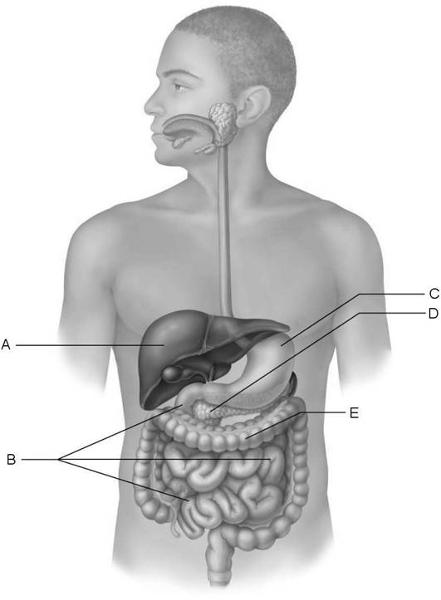 Using Figure 23.3, match the following: | back 50 17) D |
front 51 Match the following: | back 51 13. A |
front 52 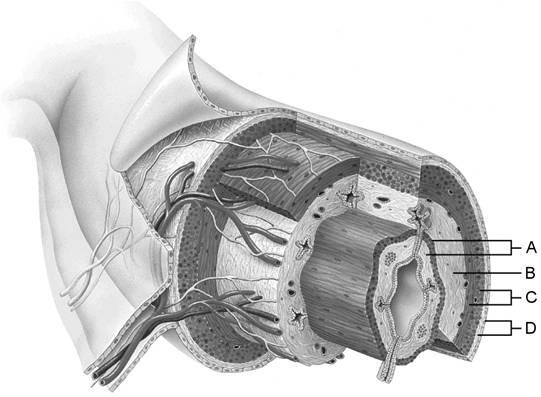 Using Figure 23.1, match the following: | back 52 1) A |
front 53 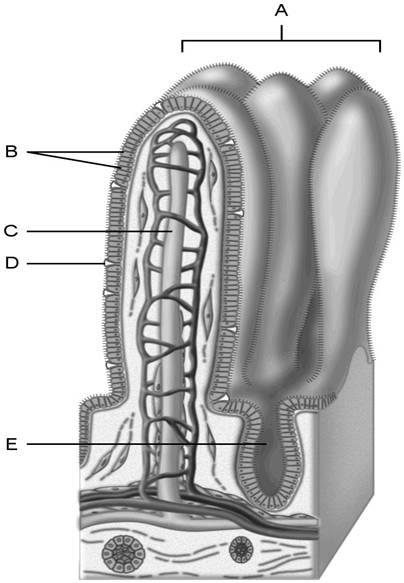 Using Figure 23.2, match the following: 8) Absorptive cells that line the intestinal tract. | back 53 8) B |
front 54 Which of the following determines lung compliance? A) airway opening | back 54 D) alveolar surface tension |
front 55 Possible causes of hypoxia include ________. | back 55 A) too little oxygen in the atmosphere |
front 56 Select the correct statement about the pharynx. A) The pharyngeal tonsil is located in the laryngopharynx. B) The auditory tube drains into the nasopharynx. C) The laryngopharynx blends posteriorly into the nasopharynx. D) The palatine tonsils are embedded in the lateral walls of the nasopharynx. | back 56 B) The auditory tube drains into the nasopharynx. |
front 57 The nose serves all the following functions except ________.
| back 57 B) as the initiator of the cough reflex |
front 58 Complete the following statement using the choices below. Air moves out of the lungs when the pressure inside the lungs is A) less than the pressure in the atmosphere. | back 58 B) greater than the pressure in the atmosphere. |
front 59 The walls of the alveoli are composed of two types of cells, type I
and type II. The function of type II is to ________. | back 59 A) secrete surfactant |
front 60 Intrapulmonary pressure is the ________. A) pressure within the pleural cavity B) pressure within the alveoli of the lungs C) negative pressure in the intrapleural space D) difference between atmospheric pressure and respiratory pressure | back 60 B) pressure within the alveoli of the lungs |
front 61 Oxygen and carbon dioxide are exchanged in the lungs and through all
cell membranes by ________. | back 61 B) diffusion |
front 62 41) Which of the following provide the greatest surface area for gas
exchange? | back 62 B) alveoli |
front 63 Which of the following is not an event necessary to supply the body with O2 and dispose of CO2? A) pulmonary ventilation | back 63 B) blood pH adjustment |
front 64 Which of the choices below determines the direction of respiratory
gas movement? | back 64 B) partial pressure gradient |
front 65 Tidal volume is air ________. B) exchanged during normal breathing C) inhaled after normal inspiration D) forcibly expelled after normal expiration | back 65 B) exchanged during normal breathing |
front 66 Which of the following maintains the patency (openness) of the
trachea? | back 66 C) cartilage rings |
front 67 The most powerful respiratory stimulus for breathing in a healthy
person is ________. | back 67 B) increase of carbon dioxide |
front 68 The lung volume that represents the total volume of exchangeable air is the ________. A) tidal volume B) vital capacity C) inspiratory capacity D) expiratory reserve volume | back 68 B) vital capacity |
front 69 Respiratory control centers are located in the ________. | back 69 B) medulla and pons |
front 70 The amount of air that can be inspired above the tidal volume is
called ________. | back 70 C) inspiratory reserve |
front 71 Nerve impulses from ________ will result in inspiration. A) the ventral respiratory group B) the chemoreceptor center C) Broca's center D) the preoptic nucleus of the hypothalamus | back 71 A) the ventral respiratory group |
front 72 The loudness of a person's voice depends on the ________. | back 72 D) force with which air rushes across the vocal folds |
front 73 The statement, "in a mixture of gases, the total pressure is the
sum of the individual partial pressures of gases in the mixture"
paraphrases ________. | back 73 C) Dalton's law |
front 74 For gas exchange to be efficient, the respiratory membrane must be
________. | back 74 B) 0.5 to 1 micrometer thick |
front 75 Which statement about CO2 is incorrect? A) Its concentration in the blood is decreased by hyperventilation. B) Its accumulation in the blood is associated with a decrease in pH. C) More CO2 dissolves in the blood plasma than is carried in the RBCs. D) CO2 concentrations are greater in venous blood than arterial blood. | back 75 C) More CO2 dissolves in the blood plasma than is carried in the RBCs. |
front 76 Which of the choices below is not a role of the pleura? A) allows the lungs to inflate and deflate without friction B) helps divide the thoracic cavity into three chambers C) helps limit the spread of local infections D) aids in blood flow to and from the heart because the heart sits between the lungs | back 76 D) aids in blood flow to and from the heart because the heart sits between the lungs |
front 77 The relationship between the pressure and volume of gases is given by
________. | back 77 A) Boyle's law |
front 78 Which of the choices below is not a functional process performed by the respiratory system? A) pulmonary ventilation | back 78 B) transport of respiratory gases |
front 79 Which of the following is not a stimulus for breathing? A) rising carbon dioxide levels | back 79 B) rising blood pressure |
front 80 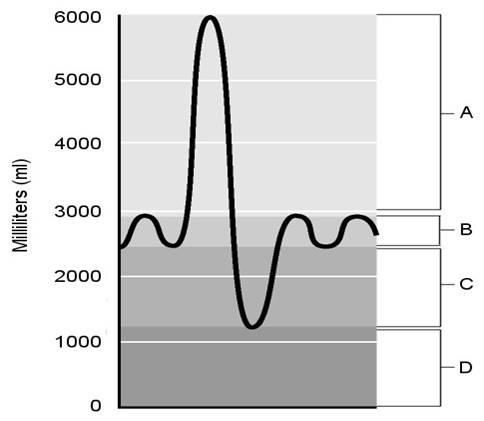 6) Tidal volume. | back 80 6) b |
front 81 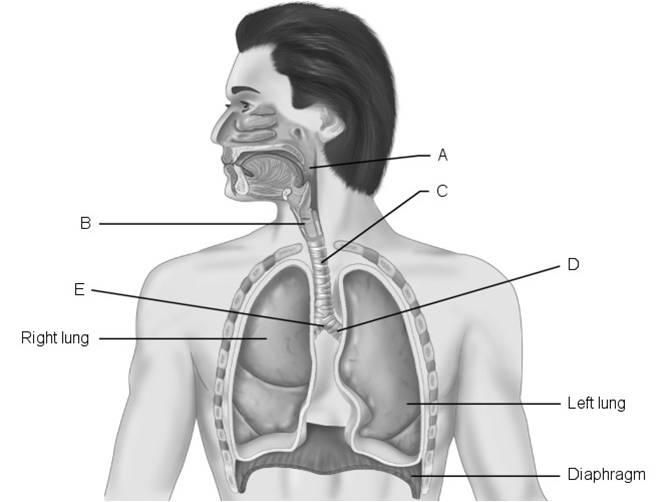 Using Figure 22.1, match the following: | back 81 1) d |
front 82 A) Respiratory bronchioles 12) Where the respiratory zone of the lungs begins. 13) Composed of simple squamous epithelium. 14) Terminates in alveoli. 15) The respiratory membrane is composed of fused basement membrane of the capillary walls and ________. | back 82 11) c |
front 83 Match the following: | back 83 14) A |
front 84 Match the following: 21) damage to it is a heart block | back 84 18) C 21) D |
front 85 A) Aortic valve | back 85 22) A |
front 86 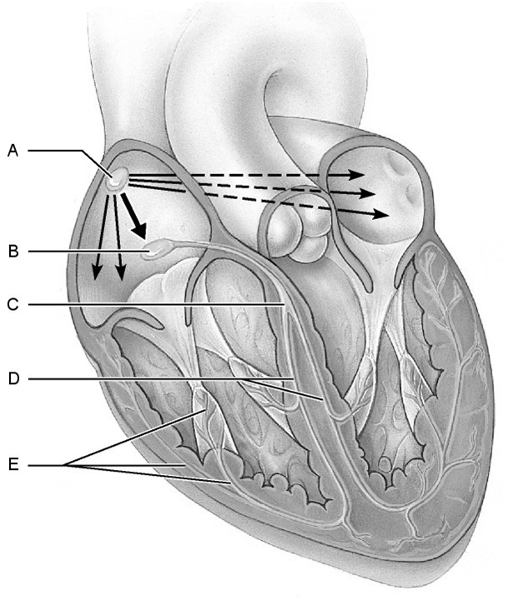 match the following: 1) Purkinje fibers. | back 86 1. Answer: E |
front 87 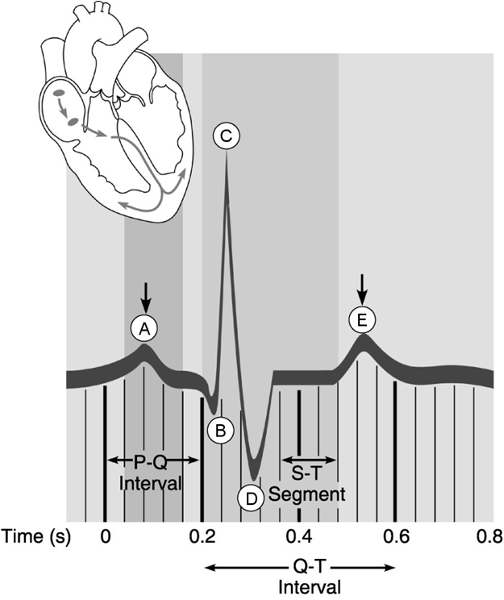 match the following: | back 87 6. Answer: A |
front 88 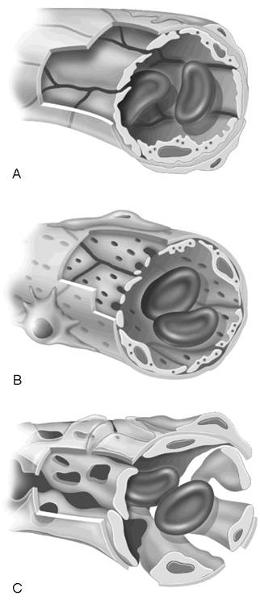 match the following: | back 88 1) C |
front 89 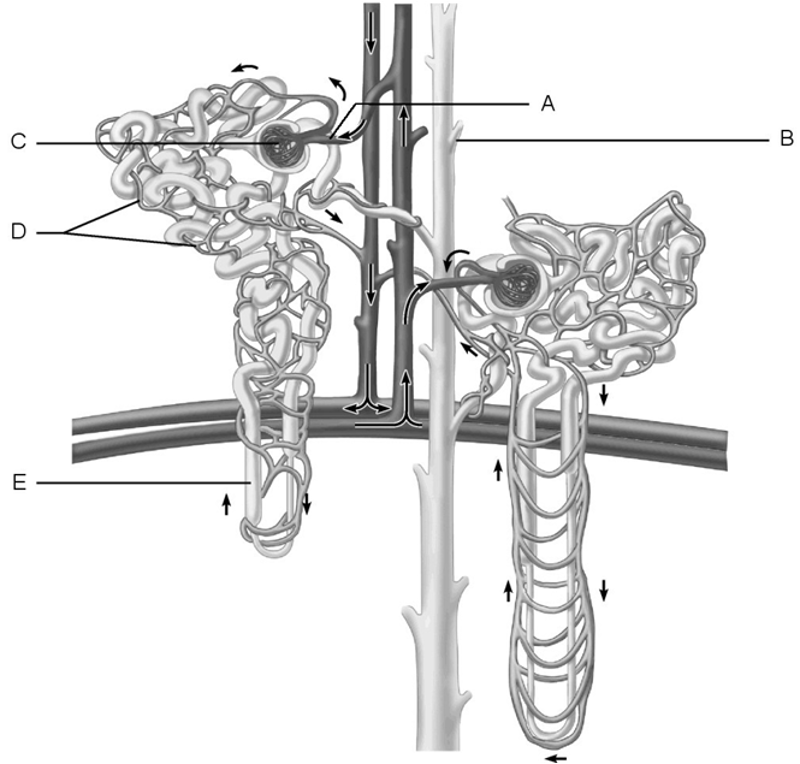 1) Glomerulus. | back 89 1. Answer: C |
front 90 Match the following: | back 90 Answers: |
front 91 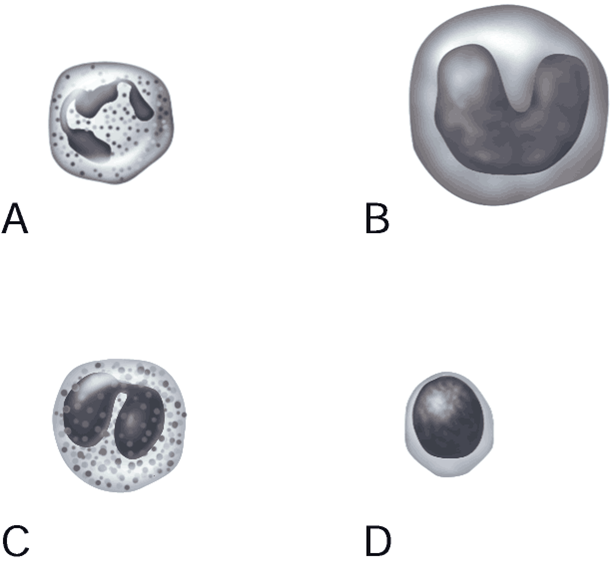 1) Monocyte. | back 91 1) Answer: B |
front 92 Match the following: 2) Condition in which blood has abnormally low oxygen-carrying capacity. 3) Free-floating thrombus in the bloodstream | back 92 1) a |
front 93 The source of blood carried to capillaries in the myocardium would be
the ________. | back 93 C) coronary arteries |